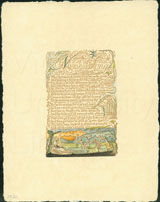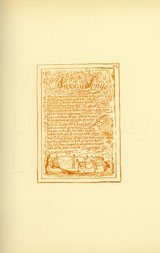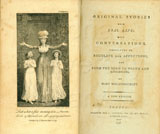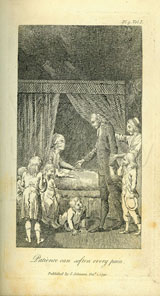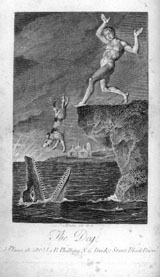The exhibit contains Blake’s two poems entitled "Nurse’s Song," prints from the Songs of Innocence and of Experience. Both speakers are adult nurses calling the children in from play. The nurse in Innocence experiences no alienation from the children; she has passed into experience with no bitterness, her imagination still vivid enough to enjoy the laughter and play of the children. The nurse in Experience has passed into adulthood bitterly, and finds no pleasure in the children, but instead limits their joys: “Your spring and your day are wasted in play, / And your winter and night in disguise.” In her repression she has turned envious, and she has lost contact with the imagination. These prints show Blake’s critique of conventional religion and morality: the limitation of desire and freedom leads to cruelty and narrow thinking.
The education of children became an increasingly important subject in the eighteenth century and public concern is reflected in various works by Blake, who thought that the imagination of children partakes most purely of the world of innocence, before the children are socialized into the world of experience. The imaginative loss that attends experience can be regained through the imaginative work of the artist.
The exhibit contains two books of moral instruction by Mary Wollstonecraft, one original and one translated, both of which contain engravings by Blake made before he composed his own Songs of Innocence and of Experience. The third item is a plate designed and engraved by Blake for Hayley’s Ballads, entitled “The Dog.” Hayley writes in the preface that the book is intended for young readers, and each poem contains moral instruction.
Manchester: Manchester Etching Workshop, 1983.
Mary Wollstonecraft.
Original Stories from Real Life.
London: J. Johnson, 1796.
Of the anonymous English engravings of 51 designs after Chodowiecki in this edition, 45 may cautiously be assigned to Blake. The text reads, “Is it the fault of the innocent people that we are afflicted? Why then should we make them suffer for it? Or by our ill-humour, drive them away, whom duty does not compel to take care of us; how much more grateful it is to be nursed rather from a motive of affection, than mere duty.”
Christian Gotthilf Salzmann. Elements of Morality: For the Use of Children.
Translated by Mary Wollstonecraft.
London: John Sharpe, [1815?].
The tale of the dog takes place in India: Fido jumps into the jaws of a crocodile in order to save his master Edward. Grief-stricken, Edward makes a marble statue of Fido, which is then placed as a permanent memorial in the chamber of Edward’s love, Lucy.
William Hayley. Ballads. Founded on Anecdotes Relating to Animals with Prints, Designed and Engraved by William Blake.
Chichester: Phillips, 1805.




